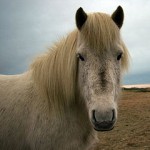Tags

The Icelandic horse is one of the most unique breeds in the world – they have been raised for over 1,000 years in isolation on the remote island, and have developed very specific traits. Horses are prohibited from being imported into Iceland, and any that leave can never return. Researchers are taking advantage of improvements in technology to analyze old DNA as part of an attempt to trace the origin of the Icelandic horse, which is generally thought to have come from Norway during the settlement period.
Rannsakar uppruna íslenska hestsins
Researching origin of the Icelandic horse
Albína Hulda Pálsdóttir freistar þess nú að greina uppruna íslenska hestsins. Hún er dýrabeinafornleifafræðingur og vinnur rannsóknina með Jóni Hallsteini Hallssyni, doktor í erfðafræði og Michael Hofreiter, doktori í líffræði.
Albina Hulda Palsdottir is trying to determine the origin of the Icelandic horse. She is a zooarchaeologist and is working on research with Joni Hallsteini Hallssyni, doctor of genetics and Michael Hofreiter, doctor of biology.
There aren’t a ton of verbs that take a genitive, so it’s always interesting to run into one, in this case að freista. Here it is part of a clause with það, which takes the form þess as a result. It’s more or less a synonym of að reyna, but most of the words related to it carry the meaning of tempt, temptation.
|
|
|||||||||||||||||||||||||||||||||||||||||||||||||
So yeah…dýrabeinafornleifafræðingur. Like any word that that is obviously a compound, just start breaking it down into parts. I recognized each piece, but it didn’t make sense to me, so yes – I googled “animal bone archaeologist” 🙂 As far as I can tell, zooarchaeologist is a good fit.
upp·runi m origin, source freista v (gen) (-aði) attempt, try dýr n animal, beast bein n bone fornleifa·fræði f archaeology erfða·fræði f genetics líf·fræði f biology
Hópurinn hefur hlotið styrk úr Fornminjasjóði upp á áttahundruð þúsund krónur. Markmið verkefnisins er að dýpka skilning á uppruna íslenska hestsins. Albína segir að tækninni til að greina forn-DNA hafi fleygt mjög fram og í dag sé hægt að greina sýni sem voru ónothæf fyrir fáeinum árum. Einnig sé til bóta að upplýsingar um erfðamengi úr nútíma hrossastofninum séu mjög góðar. Beinin sem notuð verða voru flest sótt í kuml á Norðurlandi, en einnig úr uppgreftinum á Alþingisreit. Tekin verða sýni úr beinunum og þau send utan til greiningar á forn-DNA. Albína segist hafa gaman af því að hreyfa við fastmótuðum kenningum um söguþróun.
The group has received a grant from the antiquities fund of around 800,000 kronur. A goal of the effort is to deepen the understanding of the origin of the Icelandic horse. Albina says that the technology for studying old DNA has advanced greatly, and today it is possible to analyze specimens which were unusable just a few years ago. It is also of benefit that information on the genome of modern-day horses is so good. The bones to be used were mostly obtained from a burial site in Northern Iceland, but also from the excavation at the Althing site. Samples will be taken from the bones and sent abroad for analysis of the old DNA. Albina says she enjoys contributing to long-standing theories on historical development.
The verb að hljóta is similar to að fá, but you see it used when receiving things like prizes, awards, grants.
|
|
|||||||||||||||||||||||||||||||||||||||||||||||||
The third sentence has an interesting construction. The phrase að fleygja fram is used in impersonal constructions to mean that something is going well, progressing, moving forward. It takes the dative, so what is progressing? The technology – tækni. Now tækni doesn’t change in any of its declined forms, but since the definite article is used you can see the dative in action in the form tækninni.
The last sentence gave me some trouble, and I’m pretty sure there’s a better translation, but I’m missing it.
styrkur m grant, subsidy forn·minjar f pl antiquities, relics sjóður m fund mark·mið n goal, objective sýni n specimen ó·nothæfur adj unusable, useless mengi n pool, set uppgröftur m excavation fast·mótaður adj fixed, firm kuml n pagan grave greina v (acc) (-di,-t) analyze kenning f theory
Hefðbundna kenningin er að sögn Albínu sú að öll íslensk húsdýr, ekki bara hesturinn séu upprunnin í Noregi, en sú kenning er aðallega byggð á ritheimildum. Rannsóknir sem hafa verið gerðar á nútíma-DNA manna benda á hinn bóginn til fjölbreyttari uppruna, en það gera líka samsætugreiningar á mannabeinum. Því bendi ýmislegt til þess að sú mynd sem ritheimildir draga upp af landnáminu sé einfaldari en raunin hafi verið.
The traditional theory according to Albina is that all Icelandic domesticated animals, not just the horse, can be traced back to Norway, but that theory is mainly based on written sources. Research that has been done on modern DNA of humans points on the other hand to a more diverse origin, as does isotope analysis on human bones. These various things seem to indicate that the depiction of the settlement in the written sources is far simpler than the reality has been.
I had to pull out the Icelandic-Icelandic dictionary to find samsæta; at first I found samsæti, which means dinner, banquet . So I was a little confused for a while 🙂 One clue to look at however is the letter u in samsætugreiningar. Since often the genitive singular or plural form is used in a compound, seeing a u would likely mean that the nominative form had an a. In that case samsæti wouldn’t fit, and additionally neither of its genitive forms has a u.
hefð·bundinn adj traditional hús·dýr n domestic animal heimild f sources, documentation samsæta f isotope ýmis·legur adj different, various land·nám n settlement
